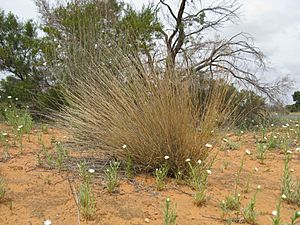Bunched kerosene grass facts for kids
Quick facts for kids Bunched kerosene grass |
|
|---|---|
 |
|
| Aristida contorta near Mildura | |
| Scientific classification | |
| Genus: |
Aristida
|
| Species: |
contorta
|
Aristida contorta, commonly known as bunched kerosene grass, kerosene grass, bunched windgrass, silvergrass, mulga grass, and sand speargrass, is a type of grass found naturally in Australia. It belongs to the plant family Poaceae, which includes all grasses. This tough grass is known for surviving well in dry, arid places.
Contents
What Does Bunched Kerosene Grass Look Like?
This grass can be an annual plant, meaning it lives for one year, or a short-lived perennial, meaning it lives for a few years. It grows in clumps and usually reaches a height of about 12 to 44 centimeters (about 5 to 17 inches).
Its stems, called culms, stand upright or grow upwards with a bend. They have two to four joints, similar to knots on a bamboo stalk. The parts of the stem between these joints are smooth and can have side branches.
The leaves have sheaths that wrap around the stem. These can be smooth or slightly rough, and either hairless or a bit hairy. At the base of the leaf blade, there's a small fringe of hairs, called a ligule, about 0.3 to 0.5 millimeters long. The leaf blades themselves are thin and flexible, about 3 to 10 centimeters long and 1 millimeter wide. They can also be smooth or slightly rough.
Bunched kerosene grass usually blooms between February and June, producing brown flowers. Each group of flowers forms an oval-shaped cluster called a panicle, which is about 9 to 26 centimeters long and 4 to 9 centimeters wide. The individual flower parts, called spikelets, are attached by small stalks and contain one flower. These spikelets are shaped like a spearhead and are about 12 to 30 millimeters long.
How Was It Named?
The scientific name for this grass, Aristida contorta, was first officially described by a scientist named Ferdinand von Mueller in 1855. He included it in his book called Description of fifty new Australian plants, chiefly from the colony of Victoria.
Over time, this grass has had a few other scientific names, which are now considered synonyms (different names for the same thing). Some of these include Aristida arenaria and Arthratherum arenarium. Aristida contorta is closely related to another grass called Aristida holathera, and they can even create hybrid plants together.
Where Does It Grow?
Bunched kerosene grass can be found almost everywhere across mainland Australia. It's very adaptable and can grow in many different types of soil, including red, white, or yellow sand, and red or brown clay or loamy soils.
This grass is especially good at surviving in Australia's driest areas. It's very common in most arid (very dry) and semi-arid (partially dry) regions. You'll often find it growing alongside Eucalyptus trees and in woodlands where Acacia aneura trees are common.
Why Is It Important?
While bunched kerosene grass is a normal part of many grasslands, it's often seen as a sign of poor pasture quality when it becomes very common. This is because it's not very tasty for animals like cattle and sheep. They prefer to eat other, more delicious grasses.
Because animals don't like to eat it as much, the amount of bunched kerosene grass in grazing areas tends to increase over time. Even though it's not the best food for livestock, it can hold moisture well and grows quite quickly, which helps it survive in dry conditions.


